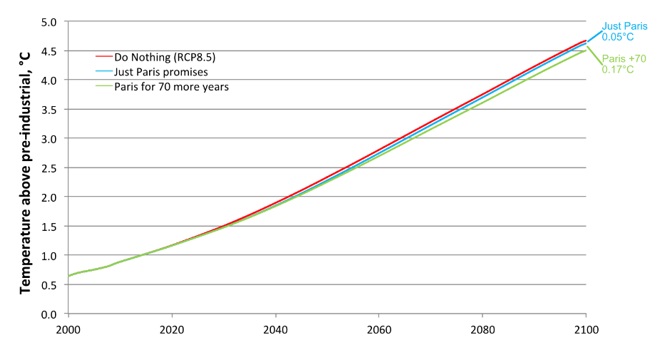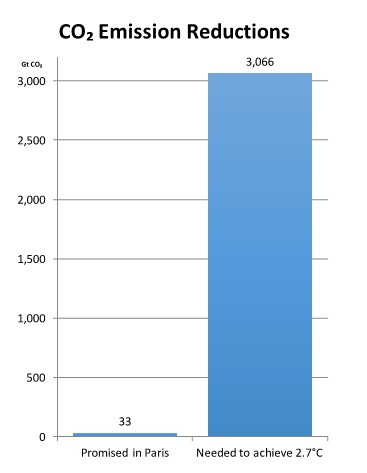Paris climate promises will reduce temperatures by just 0.05°C in 2100 (Press release)
A new peer-reviewed paper by Dr. Bjorn Lomborg published in the Global Policy journal measures the actual impact of all significant climate promises made ahead of the Paris climate summit.
Governments have publicly outlined their post-2020 climate commitments in the build-up to the December’s meeting. These promises are known as “Intended Nationally Determined Contributions” (INDCs).
Dr. Lomborg’s research reveals:
- The climate impact of all Paris INDC promises is minuscule: if we measure the impact of every nation fulfilling every promise by 2030, the total temperature reduction will be 0.048°C (0.086°F) by 2100.
- Even if we assume that these promises would be extended for another 70 years, there is still little impact: if every nation fulfills every promise by 2030, and continues to fulfill these promises faithfully until the end of the century, and there is no ‘CO₂ leakage’ to non-committed nations, the entirety of the Paris promises will reduce temperature rises by just 0.17°C (0.306°F) by 2100.
- US climate policies, in the most optimistic circumstances, fully achieved and adhered to throughout the century, will reduce global temperatures by 0.031°C (0.057°F) by 2100.
- EU climate policies, in the most optimistic circumstances, fully achieved and adhered to throughout the century, will reduce global temperatures by 0.053°C (0.096°F) by 2100.
- China climate policies, in the most optimistic circumstances, fully achieved and adhered to throughout the century, will reduce global temperatures by 0.048°C (0.086°F) by 2100.
- The rest of the world’s climate policies, in the most optimistic circumstances, fully achieved and adhered to throughout the century, will reduce global temperatures by 0.036°C (0.064°F) by 2100.
Overview in Celsius and Fahrenheit by the year 2100

Figure

The global temperature change from pre-industrial, for the Do Nothing (RCP8.5) scenario, for the global promises for Paris and for Paris extended for 70 more years, as run on MAGICC.
Comments from Dr. Bjorn Lomborg
What does this mean for the Paris Summit?
Dr. Lomborg said: “Paris is being sold as the summit where we can help ‘heal the planet’ and ‘save the world’. It is no such thing. If all nations keep all their promises, temperatures will be cut by just 0.05°C (0.09°F). Even if every government on the planet not only keeps every Paris promise, reduces all emissions by 2030, and shifts no emissions to other countries, but also keeps these emission reductions throughout the rest of the century, temperatures will be reduced by just 0.17°C (0.3°F) by the year 2100.
And let’s be clear, that is very optimistic. Consider the Kyoto Protocol, signed in 1997, never ratified by the US, and eventually abandoned by Canada and Russia and Japan. After several renegotiations, the Kyoto Protocol had been weakened to the point that the hot air left from the collapse of the Soviet Union exceeded the entire promised reductions, leaving the treaty essentially toothless.
The only reason Kyoto goals were almost achieved was the global 2008 recession. Moreover, emissions were shifted from one country to another. The EU, the most climate-engaged bloc, saw an increase in its emission imports from China alone equaling its entire domestic CO₂ reductions. In total, 40% of all emissions were likely shifted away from the areas that made promises.
Negotiators in Paris are trying to tackle global warming in the same way that has failed for 30 years: by making promises that are individually expensive, will have little impact even in a hundred years and that many governments will try to shirk from.
This didn’t work in Kyoto, it didn’t work in Copenhagen, it hasn’t worked in the 18 other climate conferences or countless more international gatherings. The suggestion that it will make a large difference in Paris is wishful thinking.”
What should countries do instead?
Dr. Lomborg said: “Instead of trying to make fossil fuels so expensive that no one wants them – which will never work – we should make green energy so cheap everybody will shift to it.
The Copenhagen Consensus on Climate project gathered 27 of the world’s top climate economists and three Nobel Laureates, who found that the smartest, long-term climate policy is to invest in green R&D, to push down the price of green energy.
Subsidizing inefficient renewables is expensive and doesn’t work. The IEA estimates that we get 0.4% of our energy from wind and solar PV right now, and even in optimistic scenarios the fraction will only rise to 2.2% by 2040. Over the next 25 years, we’ll spend about $2.5 trillion in subsidies and reduce global warming temperatures by less than 0.02°C.
Copenhagen Consensus has consistently argued for a R&D-driven approach. Fortunately, more people are recognizing that this approach is cheaper and much more likely to succeed –including the Global Apollo Program which includes Sir David King, Lord Nicholas Stern, Lord Adair Turner and Lord John Browne.
You describe a 0.05°C reduction, but the UN Climate Chief, Christina Figueres, said Paris could lead to a 2.7°C rise instead of 4°C or 5°C. Why?
Christiana Figueres quote: “The INDCs have the capability of limiting the forecast temperature rise to around 2.7 degrees Celsius by 2100, by no means enough but a lot lower than the estimated four, five, or more degrees of warming projected by many prior to the INDCs.”
Dr. Lomborg said: “That entirely misrepresents the world’s options. The 2.7°C comes from the International Energy Agency and essentially assumes that if governments do little in Paris and then right after 2030 embark on incredibly ambitious climate reductions, we could get to 2.7°C.
That way of thinking is similar to telling the deeply indebted Greeks that just making the first repayment on their most pressing loans will put them on an easy pathway to becoming debt-free. It completely misses the point.
Figueres’ own organization estimates the Paris promises will reduce emissions by 33Gt CO₂ in total. To limit rises to 2.7°C, about 3,000Gt CO₂ would need to be reduced – or about 100 times more than the Paris commitments (see figure below). That is not optimism; it is wishful thinking.

Background about the Paper
What does the paper do?
The peer-reviewed paper takes the greenhouse gas emission reduction commitments (INDCs) and runs a climate model with and without them. The paper uses the MAGICC climate model, which has been used across all five IPCC reports and was co-funded by the US EPA. It is run with standard parameters. Sensitivity analysis shows that different assumptions of climate sensitivity, carbon cycle model or scenario do not substantially change the outcome.
The paper uses the same basic methodology of Tom Wigley, who analyzed the Kyoto Protocol in a much-cited paper in 1998. As with Wigley, the approach:
- Identifies the baseline of emissions
- Extrapolates the climate policy throughout the 21st century
- Runs the baseline and emissions through a climate model, evaluating the impact of the climate policy in terms of temperature rise reduction.
- Performs a sensitivity analysis across models and scenarios.
The Lomborg paper uses the best baselines for the three major emission reducers (China, EU and US makes up almost 80%) and estimates the impact of the rest, including Canada, South Korea, Russia, Japan etc. from Boyd, Turner, and Ward (2015). The UNFCCC says in their summary report that the CO₂ equivalent reductions are between 0 and 7.5Gt with a 3.6Gt best estimate. Almost all models find similar numbers. This paper uses 6.8Gt, which is a very optimistic estimate for Paris.
Where is the paper published?
The peer-reviewed paper is published in the upcoming issue of Global Policy journal (November 2015). You can access the article online here.
Responses to Critiques
Response by Bjorn Lomborg to Bob Ward: Activism Dressed up as Science.
Response by Bjorn Lomborg to Joe Romm: Romm Critique of COP21 Impact Deeply Flawed.